
Eyelid lift is a complex hardware, injection and manual manipulation that aims to rejuvenate and model the periorbital region (area around the eyes). This part of the face is considered a zone of increased sensitivity, therefore, non-surgical aesthetic eyelid correction is a difficult task even for highly qualified specialists with extensive experience. Microsurgical cosmetology and aesthetic medicine today offer several effective methods of lifting the eyelids: radio wave lifting, biologic reinforcement with threads, contour plastics, photo rejuvenation, microcurrent therapy. You can choose the most suitable technique only after a visual examination of the problem area, studying the patient's medical history, goals and ideas about the final result.
Features of periorbital lifting
The area of the eyelids, which is also called the periorbital zone (which is not completely true, since the lacrimal apparatus, palpebral fissure, and conjunctival sac are also included in the periorbital space, apart from the eyelids), is one of the areas of the human body most sensitive to lining. thin dermis and minimal subcutaneous fat. The eyelids are musculocutaneous folds, bounded behind by conjunctival tissue and cartilage. They are located around the eye and perform several functions at once: protect the cornea and retina from the negative effects of environmental factors (ultraviolet radiation, dust, etc. ), clean the connective tissue membrane as it constantly wets the tear fluid, 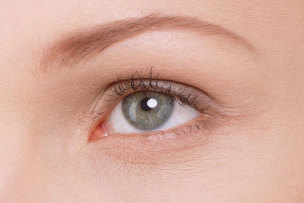 prevents drying of the eye sclera and cornea.
prevents drying of the eye sclera and cornea.
The skin on the eyelid area is several times thinner than the rest of the face, making it more susceptible to age-related changes and stress, which most people will notice after 30 years. At this age, the body's natural dehydration process begins, as a result of which the epidermal cells lose moisture, and the skin loses its elasticity, becomes loose and saggy. It is in the periorbital zone in men and women over 30 years of age that the first signs of aging are formed: hypodynamic folds, mimicking wrinkles, creases at the outer corners of the eyes ("crow's feet").
Lifting the eyelids is a complex task that only highly qualified doctors with excellent knowledge of the topographic anatomy of the eye should perform, as improper action can not only lead to new defects, but also seriously impair the functioning of the organs of vision. The fact is that the eyelids are involved in the formation of the focus of the eye and the optical geometry of the cornea, as well as in the regulation of intraocular pressure, therefore plastic surgery and improper removal can provoke a (in some cases, irreversible) impairment of visual function.
Who needs eyelid lift
Removal of the periorbital zone does not have strict medical indications (except for surgical correction, which is often used to treat pathologies that interfere with the normal functioning of the organs of vision) and is usually performed at the request of the patient to remove any visible aesthetic defects. Cosmetologists and plastic surgeons include the following defects at this disadvantage:
- strong overhang in the supraorbital fold;
- excess skin in the infraorbital musculocutaneous fold;
- drooping at the outer corner of the eye;
- periorbital bulge (fatty hernia);
- periorbital (sac) edema;
- vascular pathology that causes the appearance of rosacea scars and dark circles under the eyes;
- hypodynamic wrinkles;
- "crow's foot" (crease at the corner of the eye);
- very clear infraorbital groove;
- "aging eyelids" (skin sagging of the eyelids).
Eyelid lift also helps to create a fresher and more open look by improving sagging skin and periorbital fat pockets and enhancing the overall color of the area.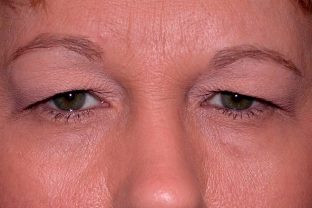 The timely use of various methods of rejuvenation of the area around the eyes helps to complete one of the main tasks of periorbital removal - to hide age-related skin changes and remove visual defects characteristic of biological aging of the dermis against the background of a decrease in the functional potential of epidermal cells.
The timely use of various methods of rejuvenation of the area around the eyes helps to complete one of the main tasks of periorbital removal - to hide age-related skin changes and remove visual defects characteristic of biological aging of the dermis against the background of a decrease in the functional potential of epidermal cells.
Important! Aging and heavy eyelids are a serious aesthetic flaw that can damage a young and attractive face. In some, signs of skin aging in this area may appear even before the age of thirty (for example, in underweight patients or in people with endocrine system pathologies). Usually, cosmetic products are not effective at fixing existing problems and are only suitable for preventing premature aging, so the only effective method of dealing with this defect is periorbital removal.
Eyelid Lift Surgery
Surgery to remove the skin on the upper and lower eyelids is called a blepharoplasty. This is a type of radical removal of the periorbital zone, in which a firming and rejuvenating effect is achieved by removing excess skin and fatty hernias in the area of the eyelids.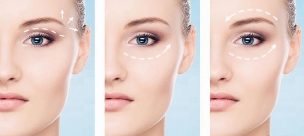 Unlike non-surgical eyelid lifting methods, blepharoplasty allows not only to correct aging skin defects and improve the appearance of these areas, but also to improve the shape and shape of the eyes, as well as to get rid of various pathologies.
Unlike non-surgical eyelid lifting methods, blepharoplasty allows not only to correct aging skin defects and improve the appearance of these areas, but also to improve the shape and shape of the eyes, as well as to get rid of various pathologies.
Blepharoplasty is effective for serious eye diseases such as entropion (protruding eyelashes and the edge of the eyelid toward the eyeball) or exophthalmos (displacement of the eyeball out of orbit). In total, there are three types of blepharoplasty: upper, lower and circular.
Tables. Types of radical periorbital removal
| Operation type | Section area | What pathologies can be corrected |
|---|---|---|
| Supraorbital blepharoplasty | Skin incision made along the orbital or tarsal fold of the upper eyelid. | Removal of excess skin, subcutaneous fat, and muscle plastics. |
| Suborbital Blepharoplasty | Transcutaneous or subcutaneous incision is performed. | Removal of periorbital edema, bags under the eyes, fatty hernias. |
| Circular Blepharoplasty | Simultaneous eyelid surgery on both sides. | Solves a problem common to all types of blepharoplasty. |
The periorbital zone tightening operation is performed strictly in a hospital setting, excluding the possibility of outpatient procedures. The patient was put under general anesthesia, and the average duration of the intervention was about 3 hours. A significant disadvantage of this method of lifting the eyelids is the postoperative period, which, despite its short duration (about two weeks), is characterized by pain, the need for regular dressing and antiseptic treatment, and significant restrictions on the regime and professional activity.
Important! The advantage of surgical blepharoplasty is its ability not only to tighten the skin of the eyelids, but also to perform plastic surgery on muscle tissue, which cannot be achieved using hardware and other minimally invasive methods.
Non-operative periorbital zone lift
Eyelid lift surgery is a very effective method for radical rejuvenation of the area around the eyes, but experts recommend using it only for patients from an older age group (after 40 years) with noticeable signs of aging and skin changesdeep age related. Before reaching this age, while tissue hydrodynamics is within the normal range, there are many less traumatic ways to correct existing problems, and the effectiveness of most of these techniques is in some cases comparable to the results of plastic surgery.
Injection plastic (contour)
Plastic contouring is probably the safest method for tightening eyelid skin without surgery, according to the technique used for mesotherapeutic procedures. Contouring is the injection of a special subdermal implant called a filler.
Preparations in the form of a homogeneous and viscous suspension or gel based on components that have a high degree of affinity for the body's own tissues. This could be:
- hyaluronic acid;
- calcium hydroxyapatite;
- collagen (a peptide that is synthesized by fibroblasts and which is one of the main constituents of the extracellular substance of the dermis, which ensures elasticity and its ability to stretch);
- polymers based on acrylic and methacrylic acid;
- high molecular weight oxygenated silicon;
- polylactic acid;
- tripolyphosphoric acid salts, etc.
The most popular and in demand filler for periorbital removal are hyaluronic acid based preparations. This is a biodegradable (absorbable) dermal implant, which not only compensates for the tissue deficiency in this area, but also helps remove wrinkles - one of the main visual signs of facial aging. The advantages of hyaluronic fillers include high hypoallergenicity and excellent yield, which can be appreciated immediately after implantation. Hyaluronate bioresorption occurs within a few weeks, after which the injection must be repeated.
Biosynthetic implants based on polylactic acid and calcium hydroxyapatite retain their properties for 1-2 years.
RF Lift
Radio wave or radio frequency removal is the removal of the area around the eye without surgery with a high degree of effectiveness.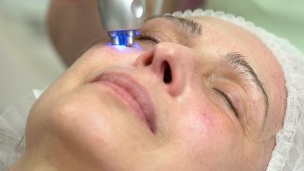 Among the hardware techniques for minimally invasive lifting of the upper and lower eyelid skin, RF-lifting takes a leading position, as it allows not only to achieve an immediate firming effect, but also to significantly improve the condition of the skin in the periorbital zone.
Among the hardware techniques for minimally invasive lifting of the upper and lower eyelid skin, RF-lifting takes a leading position, as it allows not only to achieve an immediate firming effect, but also to significantly improve the condition of the skin in the periorbital zone.
Radio waves, penetrating into the dermis to the required depth, heat epidermal cells to the temperature of collagen densification, which is about 60 ° C. Under the influence of heat energy, the dermal tissue heats up, partial withdrawal of the collagen framework occurs, as a result of which loose collagen fibersis compressed again and takes on its characteristic spiral shape, which is a lifting effect.
RF-lifting is suitable for correcting all age-related problems in the area around the eyes (crow's feet, hypodynamic wrinkles, eyelid ptosis, etc. ), and the results achieved last up to 1-2 years. To achieve a steady rejuvenating effect, you need to carry out about 6-10 procedures at an interval of at least 7-10 days.
Bio-reinforcement with thread (thread lifting)
Thread removal is a procedure to rejuvenate the area around the eyes, which is based on the implantation of special cosmetic threads made of various metals and synthetic materials under the skin, as a result of which a new collagen framework forms in the subdermal layer. This procedure is quite effective and allows you to treat the problem of "aging eyelids", fatty periorbital hernias, the phenomenon of gravitational ptosis and other characteristic phenomena of skin aging.
There are several types of threads for lifting threads. Yarns made of precious metals are quite in demand in make-up. These threads are made of platinum or gold and are designed to strengthen the top layer of the dermis. Gold threads not only provide a visible lifting effect, but also stimulate cellular metabolism, increasing the supply of nutrients, oxygen and vitamins to skin cells. A serious disadvantage of threads made of precious metal is the high risk of detaching and the impossibility of using many cosmetic procedures, for example, photothermolysis after strengthening.
Liquid mesothreads are mainly used to combat small hypodynamic creases, correct "aging eyelids" and smooth skin in the periorbital zone. The duration of such a procedure does not exceed 20-30 minutes, but strengthening with liquid threads has many contraindications and is always accompanied by various side effects (swelling, bruising, redness). Experts believe that the most effective types of eyelid threads are Swiss, polylactic, and Korean threads. The result after such strengthening lasts about 2-3 years.
Fractional photothermolysis
Fractional photothermolysis is another effective method for non-surgical lifting of the upper and lower eyelid skin. This is a type of laser rejuvenation in which a fractional laser generator (for example, an erbium laser) is used to affect the problem area. The rays generated by this device are scattered over many streams and, when hitting the skin, form a large number of microthermal healing zones, where the main effect occurs, so that the surrounding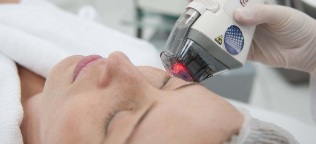 tissue does not heat up and is not injured.
tissue does not heat up and is not injured.
A distinctive feature and at the same time the main principle of action of fractional photothermolysis is to heat the skin to a temperature of 250-300 ° C, which experts call the evaporation procedure. Old cells, which are pathologically altered, and destroyed under the influence of this temperature are destroyed and evaporated, while natural neocolagenesis is activated and the activity of fibroblasts is increased, which synthesizes the main components of the extracellular matrix - peptides (collagen and elastin).
The result of fractional laser resurfacing is noticeable skin tightening on the eyelids, smoothing wrinkles and creases, restoring hydrodynamics of the periorbital tissue and improving the general condition of the skin in this area.
Pulse current (micro current)
Microcurrent therapy refers to a method of lifting the eyelid with low trauma, but a significant disadvantage of this method is its short duration of results (no more than 4 months). The clinical results of using microcurrent therapy to elevate the periorbital zone are due to the following properties of the impulse currents:
- normalization of lymph flow.The effect of lymphatic drainage, which has an impulse current to the skin, improves lymph movement, prevents stagnation and helps to brighten dark circles under the eyes;
- stimulation of metabolic processes.Activation of cellular metabolism has a positive effect on oxygen and nutrient transport as well as skin appearance (skin becomes smooth, acquires a healthy appearance);
- restoration of muscle tone.The eyelid muscles are quite weak, and the added stimulation allows you to achieve a firming effect.
The standard course duration is from 10 to 20 procedures, while in most cases it is necessary to repeat the procedure after several months.

Before and after photos
Conclusion
Lifting of the eyelid is a difficult, but doable task, because the solutions for which modern aesthetic medicine offers a large number of effective methods, including low trauma manipulation with low likelihood of complications. Which method of periorbital removal is the most effective and safe is decided individually after talking with the patient, diagnosing problem areas and studying medical history data.
The use of surgical techniques is indicated especially for patients with obvious signs of aging around the eyes, where the use of gentle techniques is ineffective and may not give a stable positive result. People with the earliest manifestations of the "age of aging" are better off choosing minimally invasive methods with low rates of tissue trauma and a short recovery period.


























































